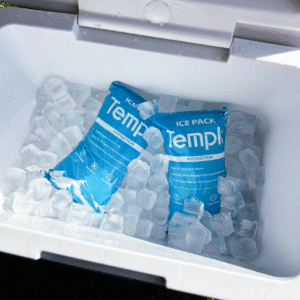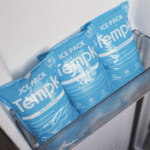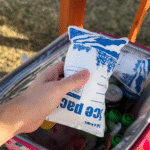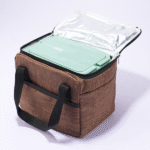Pack de glace sèche: 2025 Prix, Règles & Retour de retour
Choisir le droit coût de la glace carbonique dans 2025 réduit directement votre coût total au débarquement tout en protégeant la qualité du produit. Vous verrez les prix réels par livre, suppléments typiques, et des règles de redimensionnement que vous pouvez copier aujourd'hui. En anglais simple, nous montrons les mathématiques, quand passer aux packs de gel, et comment étiqueter correctement les envois aériens et terrestres. Vous recevrez également une mini calculatrice et une liste de contrôle rapide à appliquer lors de votre prochain envoi..

-
Comment dimensionner un coût de la glace carbonique pour des voies de 24 à 120 heures sans dépenses excessives
-
Lequel 2025 les suppléments et les règles sont les plus importants pour votre coût de la glace carbonique
-
Quand les PCM battent un coût de la glace carbonique pour un fret « à ne pas congeler » entre 0 et 8 °C
-
Comment combiner les enregistreurs de données et les choix d'isolation pour réduire le coût total
Qu'est-ce qui détermine le coût du pack de glace carbonique 2025?
Réponse directe: Prix par livre, frais de glace carbonique du transporteur, valeur R de l'isolation, chaleur ambiante, et le risque d'échec sont les principaux leviers. La glace sèche au détail atterrit généralement entre $1.60 et $3.00 par lb, et de nombreux services aériens ajoutent environ un $8 frais de glace carbonique par forfait. Planifiez autour d'un 5–10 lb par jour plage de sublimation et amélioration de l'isolation là où cela coûte moins cher que d'expédier du poids supplémentaire. Ces chiffres synthétisent les données de terrain actuelles et les conseils du transporteur.
cost_dry_ice_ice_pack
Pourquoi ça compte pour toi: Considérez la chaleur comme de l'eau qui s'écoule dans un seau. Une meilleure isolation réduit la fuite, donc tu achètes moins de glace pour la même voie. Si vous expédiez des produits surgelés pendant 2 à 3 jours, commencer près 5 lb/jour dans les expéditeurs serrés en EPS et 8 à 10 lb/jour dans le carton ondulé fin. Les niveaux de fournisseurs font baisser le prix unitaire à mesure que vous achetez plus; associez-vous à un voisin pour passer une commande de 100 lb et réduire le tarif par livre.
Quelle quantité de neige carbonique par jour pour les voies gelées courantes?
Pour les expéditeurs de taille moyenne, une gamme pratique est 5–10 lb par 24 heures. Utilisez le bas de gamme pour les conteneurs EPS ou VIP denses, et le haut de gamme pour les parois fines ou les voies chaudes. Enregistrez une course par voie avec un enregistreur de données; vous saurez si vous pouvez couper la glace ou si vous avez besoin d'un tampon pour les vagues de chaleur.
| Longueur de voie | Base livre/jour | Quand utiliser | Ce que cela signifie pour vous |
|---|---|---|---|
| 24 h, EPS/VIP | 5 | Itinéraires doux, ajustement serré | Masse inférieure, poids de fret inférieur |
| 48–72 h, PSE | 6–7 | La plupart des aliments surgelés | Contrepoids et marge |
| 72–96 h, ondulé | 8–10 | Des étés chauds, murs fins | Envisagez une meilleure isolation sur plus de glace |
Conseils et suggestions pratiques
-
Voies chaudes: Prégelez la charge utile et ajoutez un 20–30% tampon.
-
Longues voies: Divisez la glace le long des murs et du couvercle pour réduire les points chauds.
-
Ultra-congelé: Utilisez de la glace carbonique pour ≤−50°C spécifications; Les PCM seuls ne suffiront pas.
-
Validation: Exécutez un essai d’enregistreur de données pour chaque voie et coût de la glace carbonique taille.
Cas réel: Une boulangerie de la côte Ouest a remplacé les gels par un 6 pack de glace carbonique coût en lb dans une glacière EPS pendant deux jours d'air et réduisez les réclamations d'environ 30 % sans augmentation du tarif de base.
Comment dimensionner un pack de glace carbonique sans dépenser trop?
Réponse courte: Utilisez un estimateur reproductible et validez avec un essai chronométré. Un raccourci populaire pour les voies gelées est poids de la charge utile × 0.6 × jours de transit. Recoupement avec le 5–10 lb / jour heuristique et ajuster +20–30% pour les canicules ou les ondulations fines.
Exemples concrets pour une budgétisation rapide
Exemple A (2air de jour, PSE): 6 livre × $1.80 = $10.80 glace + ~$8 frais de glace carbonique + $3 matériaux ≈ $21.80–23,80$.
Exemple B (4- Jour, ondulé): 18 livre × $1.60 = $28.80 glace + $0–8$ frais + $3.50 matériaux ≈ $32.30–40,30$.
Exemple C (3air de jour, voie chaude): 29 livre × $2.20 = $63.80 + ~$8 frais + $3.50 ≈ $75.30; améliorer l'isolation est probablement moins cher.
Glace sèche ou packs de gel: quand un sac de glace carbonique économique est-il le meilleur choix?
Règle: Choisissez de la glace sèche pour ≤ - 18 ° C cibles ou voies plus longues; choisir les PCM/gel pour 0–8 ° C produits « à ne pas congeler ». La glace carbonique est à usage unique mais puissante; les gels sont réutilisables et évitent les frais liés aux matières dangereuses. Emballages hybrides utiliser un petit coût de la glace carbonique plus des PCM pour passer du congelé au réfrigéré sur 3 à 5 jours.
| Méthode de refroidissement | Coût unitaire typique | Réutilisation | Fardeau réglementaire | Meilleur ajustement |
|---|---|---|---|---|
| Glace sèche | $1.60–3,00 $ par livre | À usage unique | Classe 9 étiquette, ventilation, UN1845 | Conserver les produits ≤−18°C |
| PCM / GEL | $2–5$ par paquet | Réutilisable | Pas de matières dangereuses pour la plupart des voies | Maintenir entre 0 et 8°C ou compléter avec de la neige carbonique |
Étiquetage et sécurité pour les blocs de glace carbonique à tout prix
Faites ça à chaque fois: Les expéditions aériennes doivent être ventilées et marquées « Dioxyde de carbone, solide," avec UN1845 et kg net, plus une classe 9 étiquette. Partir 10–15 % d’espace libre. Le CO₂ se dilate ~541 L par kilogramme; ne jamais fermer hermétiquement. Une SOP d'une page avec des photos évite les frais et les retards de réétiquetage.
-
Marque Glace sèche / Dioxyde de carbone, solide.
-
Ajouter UN1845 et Poids net en kg (Par exemple, 6.0 kg).
-
Appliquer Classe 9 étiquette sur un côté vertical.
-
Utiliser ventilé conditionnement; ne jamais coller de ruban adhésif sur les bouches d'aération.
Vérifier l'auto-vérification
-
Nous avons validé au moins une voie avec un enregistreur de données.
-
Nous avons documenté UN1845 et le kg net sur chaque carton aérien.
-
Nous partons 10–15% espace libre dans chaque boîte.
-
Nous avons une alternative PCM à un coût de la glace carbonique pour voies 0–8°C.
-
Nous renégocions les niveaux de glace carbonique tous les trimestres.
2025 les tendances qui changent votre coût de la glace carbonique
Quoi de neuf: Attendez-vous à des prix par livre stables avec des fluctuations régionales, augmentations modestes des frais de transport, et une meilleure technologie d'isolation/surveillance. Les générateurs de glace carbonique portables et les doublures VIP plus légères réduisent les coûts de transport. Garder à la fois un coût de la glace carbonique et un pack PCM validé vous permet de changer lorsque la météo ou le prix évolue.
Dernières mises à jour en un coup d'œil
-
Frais de transporteur: De nombreux États-Unis. les services aériens appliquent des frais de traitement de glace carbonique aux alentours $8 par forfait.
-
Fournir: La disponibilité du CO₂ peut se resserrer localement; garder deux fournisseurs.
-
Technologie: Les enregistreurs de données cloud moins chers validation trimestrielle des voies facile.
-
Matériels: Nouveau Revêtements VIP réduire la masse de glace sans nuire au temps de maintien.
Perspicacité du marché: Modèle deux paquets par voie et négocier les conditions de supplément chaque année. Lorsque les coûts énergétiques augmentent ou que des vagues de chaleur frappent, le passage à un emballage à R plus élevé est souvent supérieur à l'expédition de 5 à 10 lb supplémentaires par jour d'un coût de la glace carbonique.
FAQ
Que comprend un pack de glace carbonique ??
Cela signifie la masse de glace, frais de transporteur, matériels, travail, et le coût du risque attendu : utilisez les cinq pour comparer les options.
La glace carbonique est-elle dangereuse?
Oui. Il est réglementé dans le transport aérien; les colis doivent être ventilés et être étiquetés. Former le personnel et mesurer le CO₂ dans les zones de transit.
De combien d'espace libre ai-je besoin?
Viser 10–15% libérer du volume et garder les bouches d'aération ouvertes; Le CO₂ se dilate rapidement à mesure que la glace se sublime.
Puis-je expédier de la neige carbonique par voie terrestre sans paperasse relative aux matières dangereuses?
Avec des marchandises non dangereuses, vous avez généralement besoin d'étiquettes et d'une ventilation appropriées, pas une déclaration complète sur les matières dangereuses. Confirmez votre guide de transporteur.
Combien de kilos par jour dois-je prévoir?
Commencer par 5–10 lb par 24 heures et validez avec un enregistreur sur vos propres voies.
Résumé et recommandations
Points clés: Ton coût de la glace carbonique est déterminé par le prix par livre, frais de transporteur, isolation, chaleur ambiante, et le risque. La bonne taille avec des calculs simples, étiqueter correctement, laisser l'espace de tête, et conserver une option PCM pour les voies réfrigérées. Validez avec un enregistreur de données et revisitez les niveaux avec les fournisseurs une fois par trimestre.
Étapes suivantes: Exécutez l'estimateur pour vos cinq premières voies, puis test A/B isolation par rapport à la masse de glace. Actualisez vos SOP d'étiquetage et planifiez une validation de voie trimestrielle. CTA: Contactez Tempk pour un modèle de conditionnement et de coût voie par voie.
À propos du tempk
Nous concevons des emballages de glace carbonique et PCM validés, expéditeurs isolés, et étiquetage des SOP. Nous aidons la nourriture, Pharma, et les équipes de biotechnologie ont réduit les réclamations de 20–40% et réduire le coût au débarquement de 10–25% en dimensionnant correctement le liquide de refroidissement et en améliorant l'isolation.






















